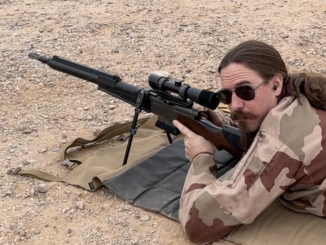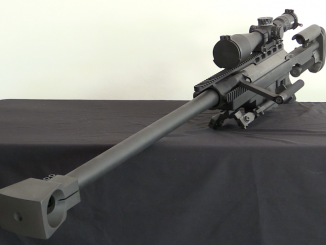EDIT: Shoot, I managed to get the gear ratio backwards. Sorry! The recoil action provides the necessary delay, and then the gear ratio provides acceleration to ensure the bolt can open reliably, akin to the accelerator in a Browning M1917 or 1919 machine gun, or a Lahti L35 pistol. Please excuse the error…
In the search for an improvement to the MAS 1949 rifle for the French military, all the French arsenals proposed new designs. MAS supplied an updated version that was ultimately adopted as the MAS 49/56, but the Tulle Arsenal (MAT) had a wacky idea of its own. In 1955, they presented a short-recoil, tilting bolt, gear-ratio-delayed system. It was an open bolt firing rifle chambered for the 7.5x54mm cartridge, using detachable 20-round magazines. Today we have one of the first models to look at, and there was a second iteration in 1956, which lightened the rifle by replacing some steel parts with aluminum. Neither was successful, much the the relief of the French Army…
Many thanks to the IRCGN (Institut de Recherche Criminelle de la Gendarmerie Nationale) for allowing me access to film this unique rifle for you!
Full video on the St Etienne Mle 1907 heavy machine gun here.




I think that this mechanism actually gives the bolt carrier a higher velocity than the barrel assembly, functioning in the same way as a more typical accelerator found in other recoil operated guns. I made a quick velocity analysis so I can be wrong. Some feedback?
Nope, you are correct, and I goofed with the gear ratio.
I don’t blame the designers for this monstrosity. Their job is to think outside the box. But the manager who spent money on the prototype should have been fired. It is obvious that the rifle would never be accepted, if for only how many small parts drop out when the rifle is cleaned and how that would just not work in the field.
I am very pleased to learn about this rifle. Could it be more French? It seems that when a lever delay gets a bit boring, they decided to use gears instead. What a nation.
“(…)when a lever delay gets a bit boring(…)”
They later developed lever delayed 5,56 mm weapon, but with 3 barrels https://guns.fandom.com/wiki/MAT_Tritube
Open bolt with selective-fire, plus recoil-operated? Double bad whammy to replace the stolid MAS 49. Not surprised by its failure.
Since France still faced replacement of their small-arms after WW2, and with all their WW2 combat experience plus post-WW2 experimentation, I’m surprised France didn’t adapt one of their .30 Carbine caliber experimental selective-fire firearms. I suppose a combination of French pride, military conservatism, and excess economizing prevented that?
I’d like to hear more about those French .30 Carbine experiments. What did the French hope for? Why did those efforts end nowhere?
I own a MAS 49/56. After seeing this video, I can only say that the French made the right choice. I am always amazed at how few moving parts there are in the 49/56. This weapon, however….. I could see this mechanism being put forward as the basis for a heavy MG, but as a battle rifle? This certainly lends credence to the old expression that the French copy no one, and no one copies the French.
It is said that designers learn as much from failures as they do from successes. Ian, Thanks for bringing us a weapon that is perhaps “best forgotten.”
This is one of those times when you just have to look on in horror, shaking your head as the designers wander off into la-la land.
I think the presence of “gears in guns” may well be a marker for “Yeah, let’s issue that to the Elbonians…” The Russian AN-94 and the various geared AK variants come to mind. Is recoil control really all that necessary?
Remember the St. Etienne M1907 heavy machine gun?
https://www.youtube.com/watch?v=ofZnarVq8pw
To avoid paying royalties to Hotchkiss, they used a long-recoil system not unlike the Soren H. Bang rifle system, but reversed it so the piston moved forward. Then linked it to a rack-and-pinion that moved the bolt back and forth.
Other than providing a preview of future automobile steering systems, it had no compelling reason to exist.That didn’t stop the French Army from building and issuing over 39,000 of them, though.
https://en.wikipedia.org/wiki/St._%C3%89tienne_Mle_1907
clear ether
eon
This is a case where adult supervision was lacking. Spending all that money on a prototype when the basics of what an army needs were obviously missing was definitely silly. Regardless of whether or not the gear mechanism was workable and had any advantages, just looking at the the impact of all those delicate and small parts, relative to soldiers having to field strip the rifle, while sitting in a muddy trench, should have stopped the project before it began.
“(…)necessary?”
Most 20th century weapon work properly without geared wheels, however they seems to have place in some weapons featuring high Rate-of-Fire.
СН aviation 7,62-mm machine gun http://airwar.ru/weapon/guns/sn.html
did employed one (see drawing in Схемы section) to reach 3000 rpm and was actually used in combat, however it was developed when rifle-caliber aviation machine gun were being outmoded by bigger caliber weapons.
L94A1 use wheels combined with chain allows weapon to be compact and thus well suited for usage inside cramped armoured vehicles.
So IMO usage of geared wheels might give feasible weapon for specific use-case.
It’s incredible this had been proposed in the ’50s.
You expect a contraption like that to have been proposed in late 19th / early 20th century (apart for the stamped steel receiver).
Considering already the Mannlicher 1885 had an accelerator, and so the patents on way simpler and sturdier accelerator designs had long expired, there was no need to make it so complex.
Not to say of the open bolt design, that was already a not so great idea in the 1932 Scotti Mod.X (and it was 1932), but the Scotti at least had a pretty lightweight bolt!
“(…)late 19th / early 20th century (…)”
If you need weapon from that era employing wheel then use Kretz https://guns.fandom.com/wiki/Kretz_rifle
The designers of the Madsen Gun incorporated just about every horrible “that can’t possibly work” idea in the book and somehow made it work. But they didn’t include any gears. There’s a lesson in that.
On the other hand Lewis machine gun used geared wheel, visible at cut-away of Mitrailleur M.20. in https://www.forgottenweapons.com/light-machine-guns/lewis-light-machine-gun/ which to my understanding was used to transmit force to induce movement of cartridges.
I can’t remember whether it was H Gabbet-Fairfax or C.H.A.F.L. Ross, who had firearms patents with lots of gears in
say no more.
gears really do not like shock loads and reversals of loads.
there’s a thought
perhaps the double thickness tooth is the one that’s engaged during initial locking and unlocking/ primary extraction?
Racks are tougher than pinions as rack teeth don’t have to be thinner at the roots
involute and even deep cyclical geometry teeth on pinions, must necessarily get thinner as towards the root
has our French genius
eaten too many brightly coloured and Strangely shaped mushroomspartially mitigated his use of gears, by using a double thickness tooth both for timing and for taking the max stress within the operating cycle?cycloidal tooth form
damn autoincorrect
Gears in rifles aren’t all bad. The Lewis machinegun, the old Bullard lever action rifle, and the more modern Browning Lever Action (BLR) all have ’em.
Except for the BLR the rest are all late 19th century designs. Even the BLR doesn’t count. Its just a rotating bolt utilizing a gear to rotate the bolt instead if a helical cut, like the old Mannlichers.
An analogy here.
For MAT to propose a rack and pinion action rifle in the mid 1950’s would rather be like Boeing proposing a biplane airliner next week.
Sure the technology is solid and proven, but it has been surpassed. It begs the question. Why?
Gears in rifles aren’t all bad…
they’re terrible
reasons why they’re terrible;
high weight and poor strength for what they’re supposed to do, especially when compared to toggles or cams
reason for the poor strength;
the need for the roots of the teeth to allow clearance for the tips of the mating teeth
teeth on a full gear or a segment of a gear, must also get narrower at their bases because they’re approaching the centre of the circle, where width becomes zero.
there are areas of engineering where, because of repeated reversals of stress, and / or shock loads, gears are either avoided entirely, or else they’re grossly over engineered, and hence far heavier than where those shocks or reversals are not present.
examples are
industrial presses
rock crushers
lots of toggle and cam mechanisms in those first two
reduction gearing between piston aero engines with fewer than 9 cylinders and a propeller
there are places where, effectively single tooth “gears” are used in guns, where that single tooth can be built to appropriate strength
an example would be the link between the lever and the tilting breech block of a martini action.
use of gears as part of the fully stressed mechanism of a semi auto rifle… a terrible idea